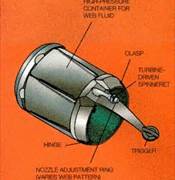History []
After being bitten by a radioactive Spider, Peter Parker decided that Spider-Man was nothing without a web, and so invented the web-shooters.

Web Shooters.
The devices have remained the same throughout most of Spider-Man's career. When he was transformed and given organic Web-Shooters, Peter modified his Web-shooters into bracelets for Mary Jane to wear, but that seems to have been retconned after the events of One More Day and Brand New Day. Ben Reilly donned a modification of them that he wore outside of the costume and allowed him to fire other web-like projectiles. Spider-Girl wears her own versions of the Web-Shooters.
One of the few modifications Spider-Man has made to the web-shooters is a red LED light, that will blink and let him know when he is about to run out of web fluid. Another upgrade is a small launcher on the back of the hand, which allows him to fire off his Spider-Tracers. In recent years, he has modified the shooters to fire on voice-command.
Creation of the Web-Shooters[]
Spider-Man's web-shooters are twin devices worn on his wrists that can shoot thin strands of a special "web fluid" at high pressure (note: the fluid itself is pressurized at 300 psi, but the actual number has been known to change). The spinneret mechanism in the web-shooter was machined from stainless steel, except for the turbine component which was machined out of a block of Teflon, and the two turbine bearings which are made of amber and artificial sapphire. The wristlets and web fluid cartridges were mainly nickel-plated annealed brass. The wristlets had sharp steel nipples which pierced the bronze caps when the cartridges were tightly wedged into their positions.
The hand-wound solenoid needle valve was actuated by a palm switch that was protected by a band of spring steel which required a 65 pound pressure to trigger. The switch was situated high on the palm to avoid most unwanted firings. An additional safety measure to prevent misfires while making a fist, is that the trigger must receive a double-tap from the middle and third fingers. The small battery compartment was protected by a rubber seal.
The effect of the very small turbine pump vanes was to compress (shear) the web fluid and then force it, under pressure, through the spinneret holes which cold-drew it (stretches it: the process wherein nylon gains a four-fold increase in tensile strength), then extrudes it through the air where it solidified. As the web fluid exited the spinneret holes, it was attracted to itself electrostatically and thus could form complex shapes. The spinneret holes had three sets of adjustable, staggered openings around the turbine which permitted a single, incredibly strong line; a more complex, spreading spray; and a thick, tremendously adhesive liquid.
The web line's tensile strength was estimated to be 120 pounds per square millimeter of cross section. The 300 p.s.i. pressure in each cartridge was sufficient to force a stream of the complex web pattern an estimated 60 feet (goes significantly further if shot in a ballistic parabolic arc).
Peter Parker devoted many hours of practice to weaving his webs in many different ways: as a shield, a parachute, a safety net, a barrier, skis, a raft, a club, a ball, or sticky glue. By weaving his webs into discs beneath his feat, he could walk across water, or fire. Given enough time, he could even create scupltures out of his webbing, which would turn into a sticky mess on anyone who would take a swing at them.
Types of Web Fluid[]
Web fluid is a shear-thinning liquid (virtually solid until a shearing force was applied to it, rendering it fluid) whose exact formula is unknown, but is related to nylon. On contact with air, the long-chain polymer knited and formed an extremely tough, flexible fiber with extraordinary adhesive properties. The web fluid's adhesive quality diminishes rapidly with exposure to air. (Where it did not make contact with air, such as at the attachment disk of the web-shooter, it remained very adhesive). After about 1 hour, certain imbibed esters cause the solid form of the web fluid to dissolve into a powder.
At one time, Peter sought to sell the formula for webbing to make money, but the company who he tried to sell it to didn't want it, not seeing the use for such a short-lasting glue.
Because the fluid almost instantly sublimates its anaerobic liquid/solid phase transition point, there is no clogging of the web-shooter's parts.
- Ice Webbing: Created specifically to combat the Human Torch, this webbing was able to hold him temporarily, untill he concentrated on burning at a higher temperature. His standard webbing was able to accomplish the same feat, albeit in a less flashy manner. Presumably, this is why he rarely used this variant.
- Acid Webbing: After a string of murders lead to William Baker, the Sandman, Peter concocted special webbing laced with Hydrochlouric Acid, which could dissolve the individual granules of Sandman's body. It proved sucessful in incapacitating but not killing him, as Peter stated he was not sure if anything could really kill him. Because the webbing looked the same as his original formula, Peter placed it into a green cartridge instead of the usual grey. He has also used this type of webbing as early as his initial encounters with the Rhino.
- Magnetic Webbing: The newest variation to his original Web-Formula with magnetized particles that will interfere with any remote-control frequencies.
